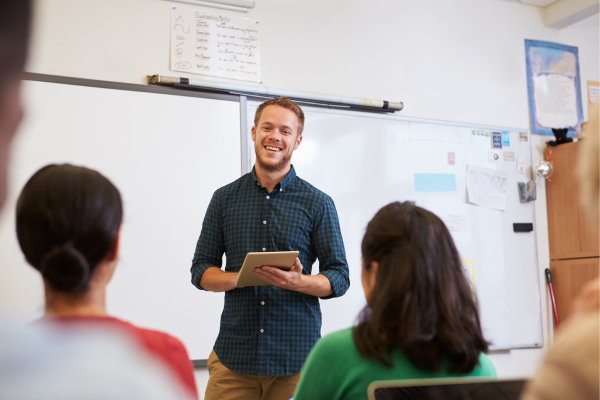Posted in: Aha! Blog > Wit & Wisdom Blog > High-Quality Curriculum > Trusting in the Process: The Transition to High-Quality Curriculum
This Month’s Focus
The importance of high-quality curriculum is no secret. A 2015 study conducted by the Center for American Progress found that improving the quality of curriculum is 40 times more cost effective than reducing class size. A 2017 study from Johns Hopkins concurs that “Curriculum is a critical factor in student academic success.” Organizations such as EdReports and Curriculum Matters are dedicated to promoting educators’ use of and access to high-quality curricula. Even knowing the benefits, however, the transition to high-quality curriculum can be a challenge for educators and can require shifts in practice. In our guest blog posts this month, Wit & Wisdom® educators Anna Barnoski and Tanniece Chinn share their personal stories of their shifts to high-quality curriculum. In this post, we build on two key ideas that Barnoski and Chinn make in their posts: to expand on the research-based benefits of high-quality curriculum and to offer reminders and inspiration to educators making this powerful, challenging shift to high-quality, knowledge-building curriculum.
High-Quality Curriculum Keeps the Focus on Joyful Learning
Anna Barnoski’s “pigeon unit” is a great reminder to teachers, coaches, and leaders: A classroom full of happy activity can—but does not necessarily—mean a room full of learning students. This is not to say the opposite—if students are not smiling and laughing, they are learning—is true! Rather, the key idea is that the starting point for instructional preparation in the classroom should be the goals for learning. After we determine what students will learn, then we can plan how to engage them in this learning.
Clare Sealy does a fascinating deep dive into these ideas in her article “The Best Way to Help Children Remember Things? Not ‘Memorable Experiences.’” She explains some of the basic science behind our episodic memories—those contextual, emotional, sensory memories of moments in our lives—and our semantic memories—our context-free, stored understandings of facts, words, concepts, and numbers. We easily remember our personal experiences (e.g., do you remember the fun experiment you did dropping the egg from the top of the playground structure?). Forming semantic memories that will help us build a base of knowledge to help us learn more requires a more purposeful approach (e.g., what did you learn when you dropped that egg?).
As caring teachers, it can be hard not to start planning by thinking about what students will feel or do in the classroom—just as Anna Barnoski planned a myriad of fun pigeon tasks and projects that she knew would leave her students feeling happily energized. That kind of careful planning and attention to students’ emotional experiences in the classroom is great—if it comes after a careful consideration of what students will think and learn in the classroom. Teachers such as Tanniece Chinn and Anna Barnoski can bring a high-quality curriculum such as Wit & Wisdom to life—knowing that every lesson has been written with a focus on students’ learning.
High-Quality Curriculum Gives Teachers Time for Their Top Priority: Student Learning
In her post, Tanniece Chinn laments the hours she lost to searching for worksheets or resources that might better help her students master key skills. So many teachers share this experience—of the “needle in a haystack” searches for the perfect resource that might make a transformative difference for their next lesson.
In “The Unexamined Cost of Teachers’ Time Spent Choosing Instructional Materials,” Robert Pondiscio reports on findings from a recent RAND study and describes how many teachers enter the profession with a vision of themselves as curators or creators of their materials. The vision of a teacher as one who implements an existing curriculum may require a shift. But, as Tanniece Chinn points out, this shift can offer great benefits to both teachers and students.
Because others have done the laborious and time-consuming work of creating a coherent set of texts, tasks, and resources that purposefully sequence learning to build knowledge of key topics, teachers can focus their attention on their students’ needs. Instead of spending out-of-class time looking for additional sources or ideas for alternate activities, teachers can spend their time internalizing the curriculum to prepare to deliver more effective, personalized instruction and feedback to their students. (The authors of the RAND study also found that teachers seeking supplemental materials might also lower the rigor of instruction. Well-meaning teachers who seek materials for their students that will be fun and with which students will have success might miss opportunities for deeper learning. So by starting with high-quality curriculum, teachers can also know that they are providing grade-level–appropriate rigorous instruction to their students.)
In Summary
Trusting in the process and having faith in curriculum can be a day-to-day challenge. But research on productive struggle shows us that true and deep learning requires us to dive into challenging tasks—and sometimes to struggle to find solutions. Just as a high-quality curriculum can require productive struggle for students, so too can it require the same struggle for teachers. But for both teachers and students, the opportunities are great.
For More
This month’s posts from our guest teacher–authors touch on many exciting and relevant topics related to Wit & Wisdom. For more on some of these topics, see these other posts from greatminds.org.
- For more stories from teachers on the shift to a high-quality, knowledge-building curriculum, see “Navigating Year One of Wit & Wisdom Implementation” and this data story from Clayton Elementary School in Englewood, Colorado.
- For a deeper dive that will give some context for Tanniece Chinn’s powerful experience recognizing the knowledge-writing connection in Wit & Wisdom, see “Writing to Learn and Learning to Write with Wit & Wisdom.”
- Both guest posts this month touch on the shift from teaching books and skills to teaching knowledge through texts. For more on building knowledge (not just skills) with Wit & Wisdom, see “Building Knowledge with Wit & Wisdom.” For more on teaching with complex texts, see “Reading Complex Texts in Wit & Wisdom.”
Submit the Form to Print

Tanisha Washington
Tanisha Washington is a Regional Director for the Humanities Implementation Success team at Great Minds®, where she shares her passion for helping educators use high-quality curriculum as a vehicle to raise their perceptions of what all students can do. Before joining Great Minds full-time, Tanisha was a public-school educator in DC for more than 15 years, during which she served as a classroom teacher and Assistant Principal and began her work with Great Minds as a Professional Development Fellow for Wit & Wisdom.
Topics: Featured High-Quality Curriculum











